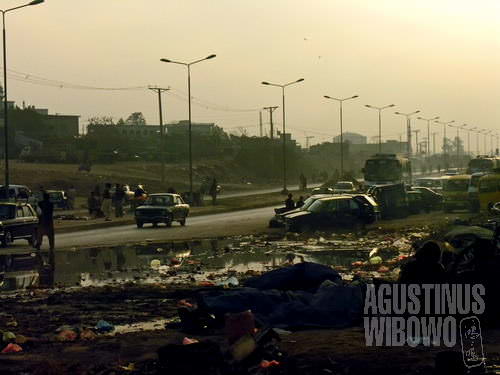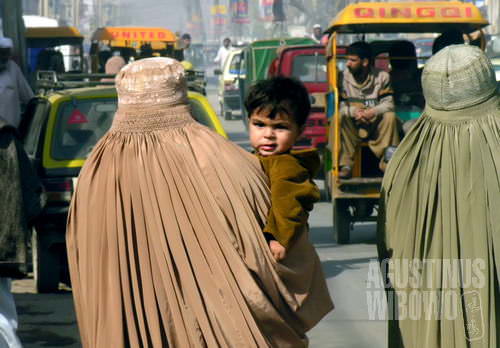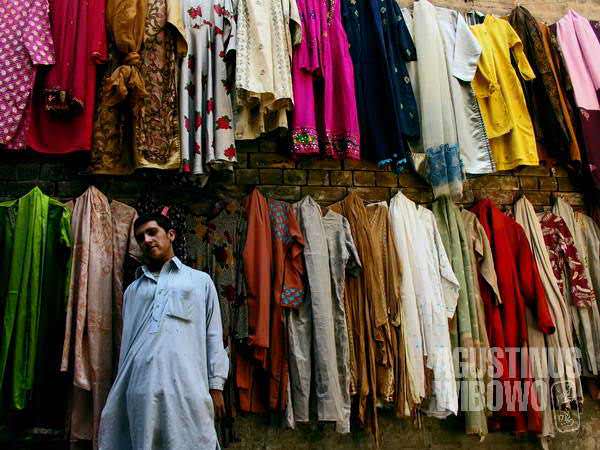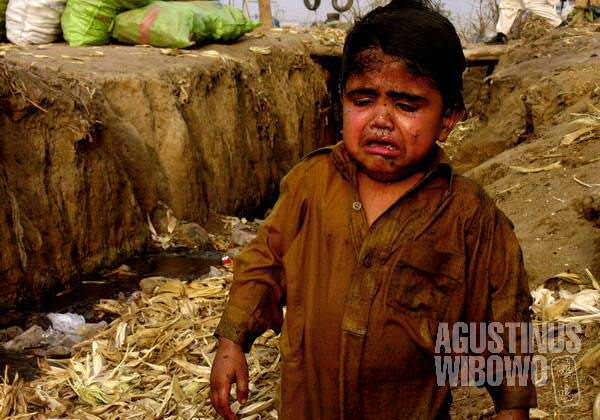Rawalpindi – Slums

Phir Wadhai
February 1, 2006
A whole day in Phir Wadhai. Phir Wadhai might be never been in any places you wanna visit. Phir Wadhai is the most important transport hub in Rawalpindi, where you can get bus from here to anywhere in Pakistan. But as other bus terminals in Java (Indonesia), Phir Wadhai is another stinky and polluted place.
First I saw the place at a glance from the bus which took me from Gilgit to Pindi. I suddenly ‘fell in love’ with it. The huge stinky pond of unflowing water flourishing the road, while people selling fruits, grilled meat, rice, and anything ‘eatable’ around the stinky black water. The environment made me curious how people here survive, and at last I decided to spend a full day in Phir Wadhai to discover the life here.
Rawalpindi is a harsh metropolitan, with dreams to offer about high income to the villagers all around Pakistan. Here you can meet people from Northern Areas, Balucshistan, Sindh, Punjab, from big cities like Karachi and Lahore until small villages in the middle of Thar desert. The life here is not that easy, of course. Many of these people are uneducated, so they end up by being waste pickers, fruit sellers, or merely beggars.

The atmospheric bus station of Phir Wadhai

Aeroplane service center
Despite of the poverty, the hospitality of Pakistan is always everywhere. Fariat, from Lahore, 18 years old, selling ‘fruitchat’ (a kind of fruit salad) just next to the hustling bustling bus station, offered me a plate of fruitchat as sign of friendship. I tried to refuse, but he insisted. The area is full of have-nots people, they who try to find treasure in the trash bins, and some who sleep on the street without anything. But compared to India, the life of the grass root people is not too much miserable.
Around the bus station, you will say many children, aged not more than 12 years old, picking the waste from the rubbish mountains. It seems that this is a suitable work for children, as their parents probably doing begging or selling food for the thousands of bus passengers. There are “corn drying” business near the station, to supply corn despite of the season. Some children picking the leaves of the corn, people told me that;s for food. The leaves of the corn were thrown by the corn processing factories (all in traditional way, mostly owned by Pathans from Peshawar). Other people earn their life by living as second hand electronics sellers (the second hand stuff are those already ‘unusable’ anymore for most people), car service, bus information service, etc. Not so much different from life near the bus station in Surabaya.

Let’s have lunch

Women in burqa
Wandering around the slum, with concrete houses around (compared with paper houses in India), I was invited by a young soldier to visit his camp. There are 5 people staying in the room at a time, means 5 people sleeping at night, 5 other people sleeping during the day, due to the shift. The camp for the soldiers is quite simple, small, and not luxurious at all. Again here the hospitality is the rule. Tea to entertain guests is a must, and even he tried to order me food. Samad, from Manshera, with most men in his family are soldiers, even invited me to go to Manshera immediately. When I leaved, another soldier accompanied me to walk thru the dark stairs. When I said salaam to him, he hugged me (a common Pakistani way), then his another hand touched my butt. I didnt notice so much as this happened to me for many times in Pakistan. But when I turned my body away and began to leave, he screwed my butt and said, “yih accha hai!” (this is a good stuff….!)
I was so surprised and ran away.
The women from the slums are also there, living just next to the bus stations. They have babies. And the babies sleep in the open air, one in the woman’s arm. Taking pictures of women is risky in Pakistan. One of the women invited me to take pictures of her and her baby, but when she saw her pictures of her in the monitor, she screamed and asked me to leave. “Jao… jao…” Their life is difficult, their tradition is very supressing, and the men domination in every aspect of the life…. the frustration might be aroused when the men came around the women, seeing what pictures were taken, and the baby cried because of the crowd.

A woman beggar with her baby

Happy faces of the slum

Cloth market
What might astonish you here, is that the fact about beggars. Of course there are beggars, who ask for alms from others. But the number is incredebly low, uncomparable with India or even Indonesia. The poor here, still prefer to support themselves by their own way, and not begging. Some beggars are old ladies with baby or totally handicapped men. Children didnt ask for money, well, just one or two. But in India, even girls from a well-being family, also asked for “one rupee, one pen” from foreigners. There begging was a fashion, where the young children might be proud if they can earn something from foreigners, and the parents (similarly wearing very good and clean clothes, obviously that they live sufficiently) were just seeing without any objection when the children beg.
The children of the slum, of course with no TV to watch, no computer for internet connection, play happily in the rubbish mountains. They jumped here, jumped there. Even rubbish can bring enjoyment. There was a small sewage, where children play jumping games. They were more excited when a stranger taking pictures of the game. One boy, about 7 years old, jumped. And his concentration was distracted, he jumped into the black watered, stinky sewage canal. He cried loud after that, while his all other friends laughed loud on him. A happening that made me remember my childhood (minus the stinky water from the sewage)

World of garbage

Crying after fell down to the mud and garbage ditch
The life here is more closed than India. While in Indian slums people are always happy and excited with guys, it’s not always in Pakistan. One family, from Peshawar, threw me with stones when I passed their house and stopped for a moment to take pictures. Throwing stones is something quite familiarly done by people from Peshawar, had the same experience 2 years ago in Peshawar. Young boy, of 8 years old, has started to chew neshvar already. Their life in the Afghan border is a hard life, and that became part of the tradition also. Here, in Phir Wadhai, there is huge population of Pathan, who put the women under burqas (full veil that you even cant see the eyes), blue, white, or yellow coloured.
I have read somewhere on the net, the comparison between how much money the richest 10% of the population earn with the poorest 10% people of the population in many countries, the value of Pakistan is comparable with Indonesia and India.

Mysterious world behind the concrete walls






hmmm….half of the story sounds just like some part of Indonesia.
oh…i forgot.
“yih accha hai!”
Difficulty around us,like what had said in titik nol book about slum in Mumbai … They are visible BUT invisible. I want to huge that boy whose crying